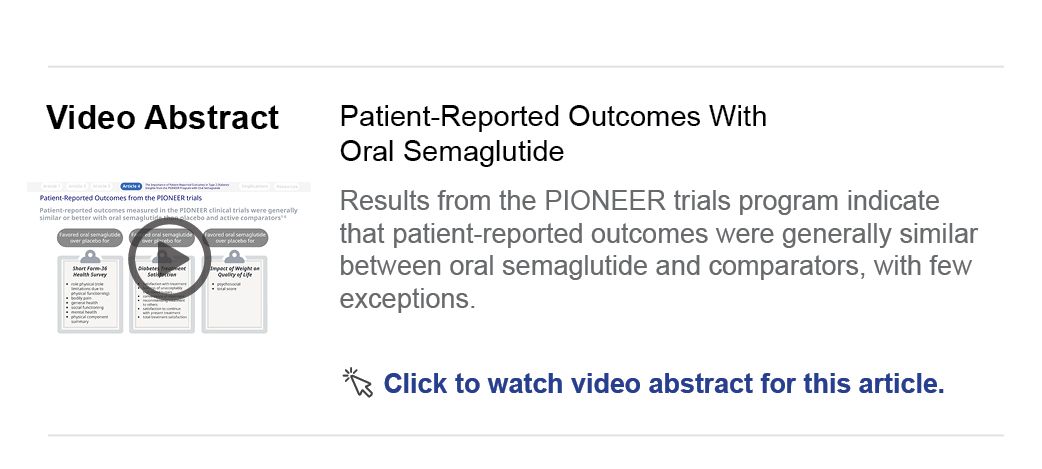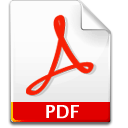- Center on Health Equity & Access
- Clinical
- Health Care Cost
- Health Care Delivery
- Insurance
- Policy
- Technology
- Value-Based Care
The Importance of Patient-Reported Outcomes in Type 2 Diabetes: Insight From the PIONEER Program With Oral Semaglutide
Abstract
Patient-reported outcomes (PROs), including treatment satisfaction, patient well-being, and quality of life, are becoming increasingly important contributors to treatment decisions in clinical practice and the evaluation of health care services. PROs have been included in a number of clinical trials in patients with type 2 diabetes (T2D), including those investigating glucagon-like peptide-1 receptor agonists (GLP-1RAs). The first oral GLP-1RA, oral semaglutide, was approved in the United States in 2019. Four PROs were included in the PIONEER clinical study program that evaluated oral semaglutide in patients with T2D across the full diabetes disease spectrum. PRO findings in the PIONEER studies were generally similar for oral semaglutide and comparators, with some exceptions. Improvements in a number of the 36-item Short Form Survey domains were observed for oral semaglutide versus placebo, including general health, bodily pain, physical component summary, social functioning, and mental health. For general health and social functioning, differences significantly favored oral semaglutide versus empagliflozin, whereas role-physical and the physical component summary significantly favored empagliflozin compared with oral semaglutide. The Diabetes Treatment Satisfaction Questionnaire findings indicated that oral semaglutide improved feelings of unacceptably high blood sugars versus placebo (in PIONEER 4, 5, and 8) and sitagliptin (in PIONEER 7). Significant improvements in craving control and craving for savory were observed with oral semaglutide versus empagliflozin in the Control of Eating Questionnaire (in PIONEER 2). These data provide valuable information that can facilitate a patient-centered approach and guide decision-making in managed care to optimize each patient’s treatment experience.
Am J Manag Care. 2020;26:S356-S367. https://doi.org/10.37765/ajmc.2020.88556
For author information and disclosures, see end of text.
Introduction to Patient-Reported Outcomes in Type 2 Diabetes
Patients with type 2 diabetes (T2D), a chronic metabolic disease, often feel overwhelmed and frustrated by the daily challenges of disease management.1,2 Long-term management of T2D involves the requirement for diet and lifestyle changes, which, in addition to medication, can affect patients’ quality of life (QOL).3 Patients need to monitor their food and beverage intake, maintain physical activity, and appropriately utilize their medication to optimize their blood glucose levels.2
The latest standards of care from the American Diabetes Association (ADA) and the American Association of Clinical Endocrinologists/American College of Endocrinology (AACE/ACE) generally recommend a glycated hemoglobin (A1C) target of 6.5% or less (AACE/ACE) or less than 7% (ADA), but stress the need for an individualized approach with shared decision-making.4,5 Also, the need to consider and evaluate factors beyond glycemic control, such as the presence or risk of atherosclerotic cardiovascular disease, heart failure, and chronic kidney disease, requirement for weight loss, risk of hypoglycemia, cost, and QOL is now widely accepted.6,7 Patient-reported outcomes (PROs) include treatment satisfaction, patient well-being, and QOL.6 Improvements in treatment satisfaction could aid medication adherence and persistence,7 which in turn may facilitate the achievement of long-term glycemic stability and help prevent the development (or progression) of diabetic complications.6
Clinicians, researchers, and regulators agree that assessing PROs in those with T2D can significantly contribute to treatment decisions in daily practice.8 As PROs reflect the patient’s experience, they can complement clinical outcomes, helping health care professionals better understand the patient’s perception of living with the disease and the physical, social, and emotional impact of treatment regimens on their daily lives.8 There are several well-established PRO instruments used in patients with T2D, as shown in the Table.6,9-17
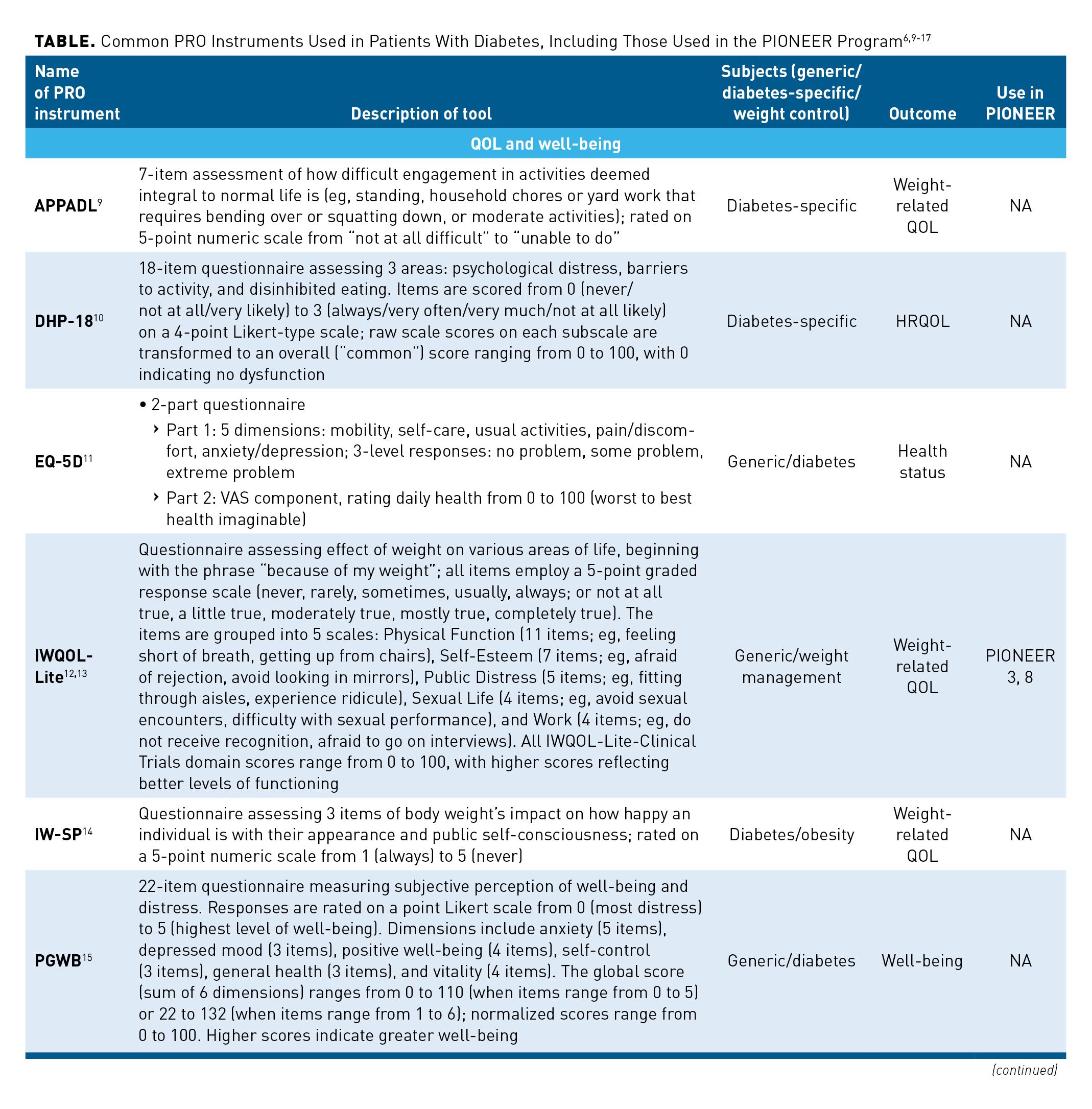
There have been increasing calls for greater use of PROs in research and, more importantly, in routine care.8 Various PRO measures are used internationally in patients with diabetes.6 These studies are a valuable resource, increasing our understanding of the utility of PRO data to inform clinical decision-making. Those involved in health care management at a local, national, and international level are now increasingly looking to data from PRO measures to not only inform individual patient care, but also for comparing and improving the quality of care.18 The ADA and European Association for the Study of Diabetes recommend adopting a more patient-centered approach, taking into account patient factors and preferences when selecting treatment strategies.19,20 These recommendations note that “patient preference is a major factor driving the choice of medication.”20 Therefore, incorporating shared decision-making between the clinician and patient regarding diabetes treatment selection can help to identify those outcomes that are most important to each patient. This increased patient focus has potential implications for the future role of PROs in the evaluation of health care services.20-22 Patient care experience assessments are used to evaluate the quality of care and can guide Medicare and many US commercial insurance quality-based payment structures.
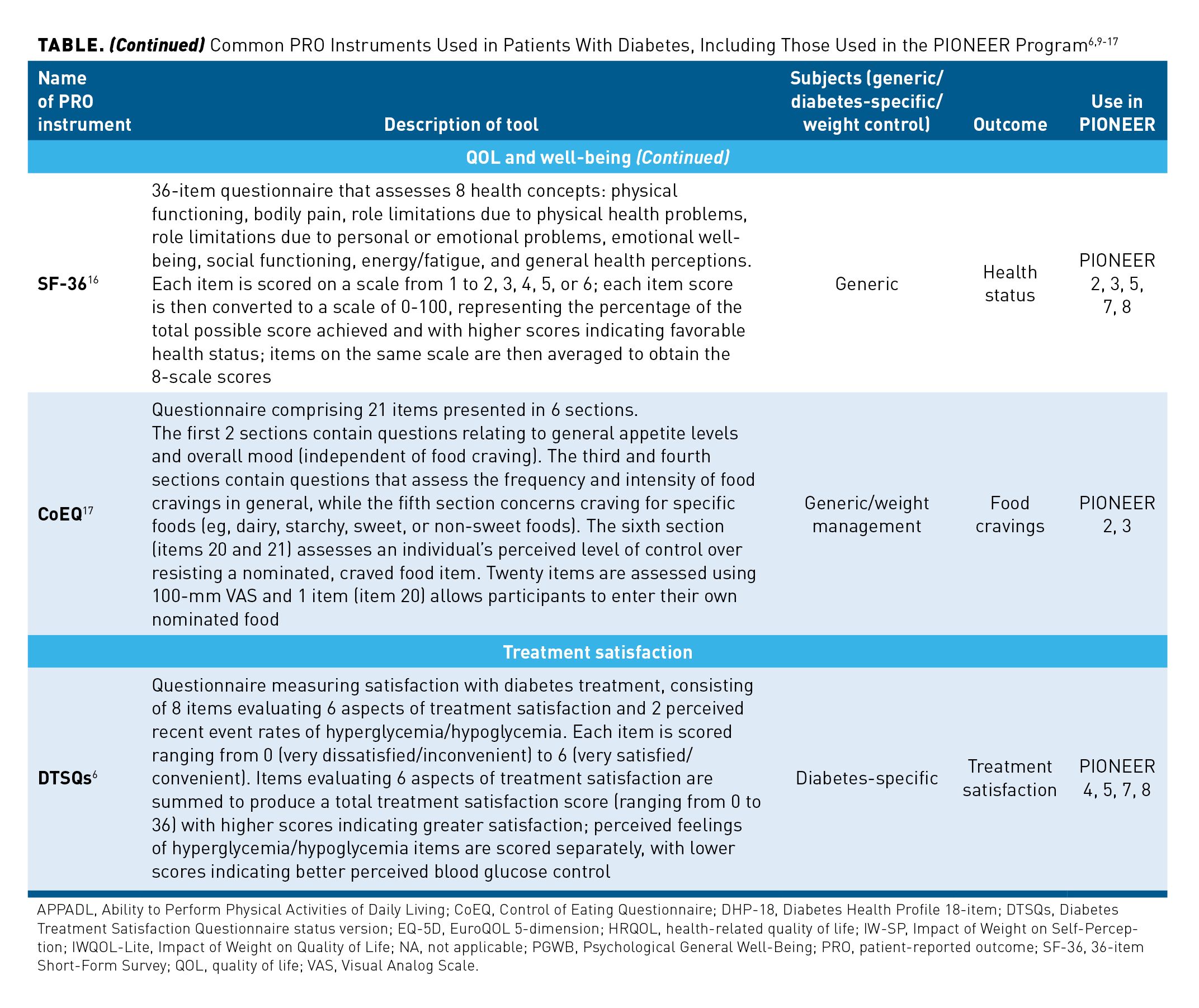
There is particular interest in PROs in clinical studies for medications, such as glucagon-like peptide-1 receptor agonists (GLP-1RAs), both in the context of their efficacy and safety profiles, and in their method of delivery and dosing schedules.23-25 The majority of glucose-lowering medications are associated with weight gain (insulins, thiazolidinediones, and sulfonylureas), or are weight neutral (metformin and dipeptidyl-peptidase-4 inhibitors).26,27 Weight gain is likely to have implications for patients’ physical and mental well-being, and the combination of T2D and obesity has been shown to negatively impact QOL.28,29 Treatment with GLP-1RAs and sodium–glucose cotransporter 2 inhibitors is associated with weight loss,27,30 which may improve patients’ QOL. Research suggests that patients prefer oral agents due to a fear of needles, and the desire to avoid injections due to the associated social stigma.31 As reviewed in another article in this supplement,32 until recently, GLP-1RAs were available for injection only; in September 2019, semaglutide became the first oral GLP-1RA approved by the FDA for T2D,33 and has since been approved in the European Union, United Kingdom, and Japan.34,35
The PIONEER clinical trial program for oral semaglutide included PRO measures in addition to efficacy and safety outcomes.36-41 This article describes the role of PROs in the PIONEER program and considers the findings from these assessments in the context of the efficacy outcomes. In addition, it is discussed how these observations could assist managed care professionals in making more informed treatment decisions for patients with T2D.
PRO Assessments in the PIONEER Clinical Trial Program
Patients representative of those with T2D typically encountered in clinical practice were enrolled into the PIONEER program, an overview of which is presented in another article in this supplement.42 PIONEER 2 through 5, 7, and 8 included PROs as supportive secondary end points (Table6,9-17). Data are presented for the treatment policy estimand, which evaluated the treatment effect in all randomized patients, regardless of premature discontinuation of study drug or receipt of additional glucose-lowering medications (ie, rescue medication). Despite the potential confounding effect of rescue medication, the treatment policy estimand may more closely reflect clinical practice than the trial product estimand, which excluded patients who discontinued study drug or received rescue medication. The rationale for estimands and those selected for use in the PIONEER clinical trial program are reviewed in detail elsewhere.43
The results presented focus on the approved maintenance doses of oral semaglutide 7 mg and 14 mg (where applicable according to the study),33 and for data at weeks 26 and 52. The estimated treatment difference (ETD) in the change from baseline to week 26 or week 52 between semaglutide and comparator are presented.
PRO Tools Used in the PIONEER Clinical Trial Program
PRO tools were used in the PIONEER clinical trial program (described in the Table6,9-17) to measure patient satisfaction, and the impact of treatment on well-being, QOL, and weight-related QOL with oral semaglutide versus comparators (Figures 1-436-41).

The 36-item Short-Form Survey version 2 (SF-36v2) was used in PIONEER 2, 3, 5, 7, and 836-40 to compare the impact of semaglutide and comparators on patients’ health-related QOL (HRQOL). It is commonly used to measure HRQOL and general health across diseases, including T2D.16 The SF-36v2 was developed due to some challenges in using the original SF-36 questionnaire in practice, which included some difficulties with wording interpretations, confusion caused by the standard layout, and insensitivity in some population settings.44 Using the SF-36v2, patients’ overall health status and QOL are measured using 8 domains (Table6,9-17).
The Diabetes Treatment Satisfaction Questionnaire (DTSQ) status version (DTSQs) was used in PIONEER 4, 5, 7, and 8.38-41 The DTSQ is widely used to assess patient satisfaction with their diabetes treatment in terms of convenience, flexibility, and general feelings regarding their treatment.6 The questionnaire is composed of 8 questions scored on a scale ranging from 0 (eg, very dissatisfied/inconvenient, or none of the time) to 6 (eg, very satisfied/convenient, or most of the time). Six questions cover satisfaction and 2 questions assess the burden of hypoglycemia and hyperglycemia.6 The DTSQ is validated and recommended for use by the World Health Organization and the International Diabetes Federation.3,6 Treatment satisfaction is an important end point in diabetes research, as it is considered a leading indicator for adherence to therapy in clinical practice.7 Adherence to oral glucose-lowering medications is part of the quality metrics for many managed care organizations.
The Control of Eating Questionnaire (CoEQ) was used in PIONEER 2 and 3.36,37 This is a reliable and validated tool comprising 21 items designed to assess the intensity and type of food cravings, subjective sensations of appetite and mood, and the individual’s perceived level of control against a craved food item.17 The PIONEER clinical trial program used a modified version of the CoEQ (items 3-19 in the questionnaire), with the 2 open-ended items (20 and 21) for patient-perceived level of control over resisting their own “problem” food excluded.
The Impact of Weight on Quality of Life-Lite-Clinical Trials Version (IWQOL-Lite-CT) questionnaire was used in PIONEER 3 and 8.37,38 The IWQOL-Lite-CT is a reliable, valid, and responsive measure used to assess changes related to weight on QOL.12
Clinicians are likely less familiar with the CoEQ and IWQOL-Lite-CT, which have not been widely used in diabetes clinical trials. However, they are of interest in the context of GLP‑1RAs, to determine if changes in body weight correlate with patient perceptions of eating and impact of weight on QOL.
PRO Observations From the PIONEER Program
Observations for SF-36v2
ETDs between oral semaglutide and comparators for SF-36v2 domain scores in PIONEER 2, 5, and 8 are shown in Figure 1.36,38,39 In patients with uncontrolled T2D taking metformin in PIONEER 2, observations for the majority of components on the SF-36v2 were similar with oral semaglutide 14 mg and empagliflozin 25 mg. The ETDs for general health and social functioning domains at week 26 significantly favored oral semaglutide over empagliflozin.36 In contrast, the ETDs for role-physical and physical component summary domains at week 52 significantly favored empagliflozin over oral semaglutide.36 In PIONEER 3, SF-36v2 domain scores were similar between oral semaglutide 3, 7, and 14 mg and sitagliptin 100 mg at weeks 26 and 52.37 These findings were similar despite significant improvements in A1C levels with oral semaglutide 7 mg and 14 mg compared with sitagliptin 100 mg over 26 weeks.37 SF-36v2 domain scores were also similar between oral semaglutide (flexible dosing) and sitagliptin 100 mg in PIONEER 7.40
For patients in PIONEER 8 who had more advanced T2D uncontrolled despite receiving insulin with or without metformin, the ETDs significantly favored oral semaglutide over placebo for general health at week 52 (7 mg and 14 mg) and mental health at week 26 (14 mg). These improvements were observed along with the superior reductions reported in A1C levels and body weight with oral semaglutide versus placebo.38 In patients with renal impairment in PIONEER 5, the ETDs at week 26 significantly favored oral semaglutide 14 mg over placebo for the physical component summary and the role-physical, bodily pain, and social functioning domains.39
Observations for the DTSQs
ETDs between oral semaglutide and its comparators for the DTSQs were collected in PIONEER 4, 5, 7, and 8 (Figure 2).38-41 For feelings of unacceptably high blood sugars (item 2), the ETDs significantly favored oral semaglutide over placebo (PIONEER 5 and PIONEER 8) and sitagliptin (PIONEER 7).38-40

In PIONEER 4, the ETDs favored oral semaglutide 14 mg over placebo for all questions at weeks 26 and 52, except flexibility of treatment (week 52) and feeling of unacceptably low blood sugars at weeks 26 and 52.41 There were no differences between oral semaglutide 14 mg and liraglutide 1.8 mg across any of the questions.41

In PIONEER 7, differences in DTSQs scores at week 52 between oral semaglutide and sitagliptin were similar for the majority of items, including treatment satisfaction, but significantly favored oral semaglutide for feelings of unacceptably high blood sugars.40 In light of this, it is important to note that similar treatment satisfaction between oral semaglutide and sitagliptin occurred despite the dosing instructions being potentially more burdensome for oral semaglutide. In PIONEER 5, differences in DTSQs scores at week 26 between oral semaglutide and placebo did not reach significance, except for feelings of unacceptably high blood sugars, which significantly favored oral semaglutide 14 mg.40 In patients receiving insulin therapy in PIONEER 8, differences significantly favored oral semaglutide 7 mg and 14 mg over placebo for total treatment satisfaction at weeks 26 and 52.38
Observations for CoEQ
ETDs between oral semaglutide and comparators for the CoEQ from PIONEER 2 and 3 are shown in Figure 3.36 In PIONEER 2, ETDs significantly favored oral semaglutide 14 mg over empagliflozin
25 mg for craving control at weeks 26 and 52 and craving for savory at week 52.36 Changes in body weight were similar between treatments at weeks 26 and 52.36 In PIONEER 3, changes from baseline were minor, and no significant treatment differences between oral semaglutide 3, 7, and 14 mg and sitagliptin 100 mg were observed for any CoEQ domains.37
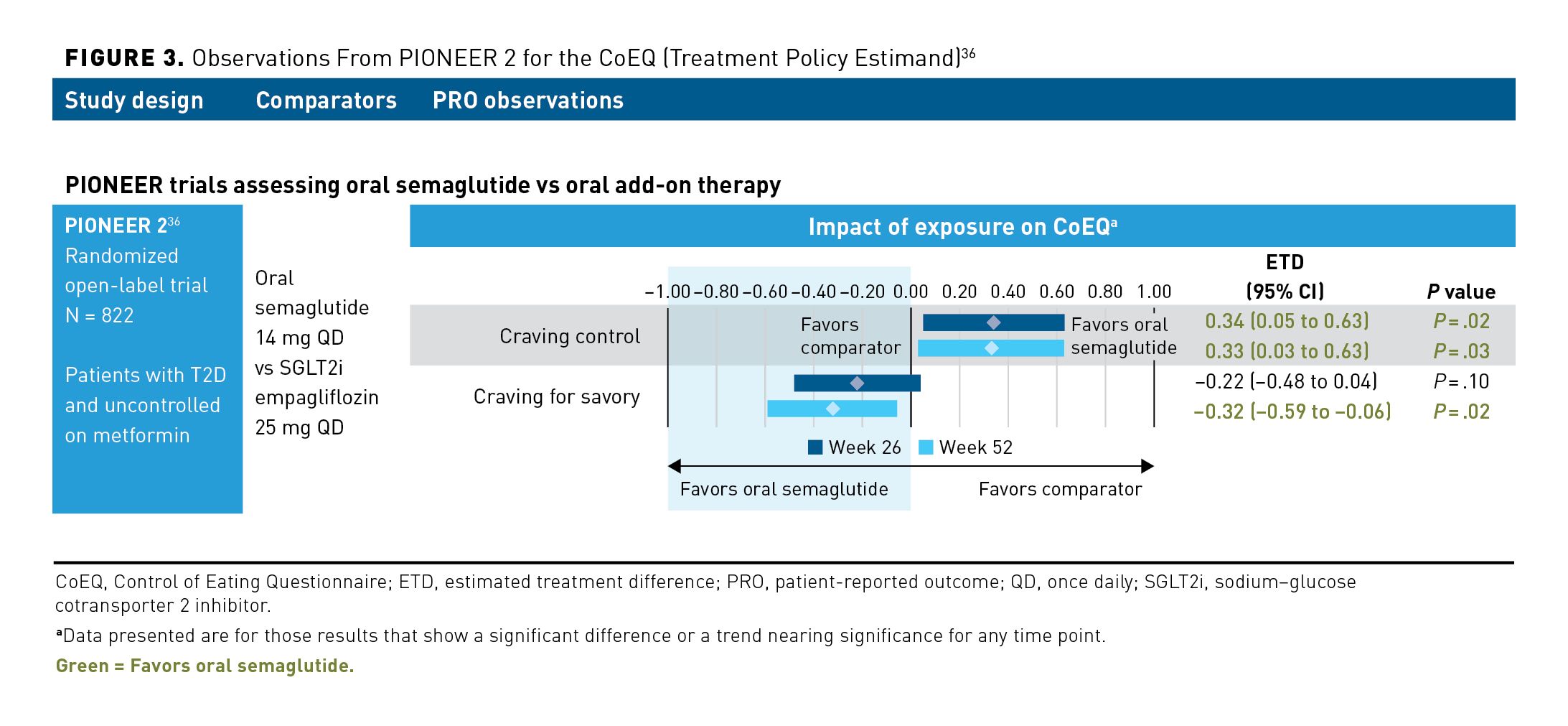
Observations for IWQOL-Lite-CT
ETDs between oral semaglutide and comparators for the IWQOL-Lite-CT in PIONEER 3 and 8 are shown in Figure 4.37,38 In PIONEER 3, the ETDs significantly favored oral semaglutide 7 mg and 14 mg over sitagliptin 100 mg at week 52 for physical and physical function domains. The ETDs additionally favored oral semaglutide 7 mg for the psychosocial function domain and IWQOL-Lite-CT total score.37 These PRO findings reflect the efficacy observations, with both oral semaglutide doses resulting in significant reductions in A1C levels and body weight.37
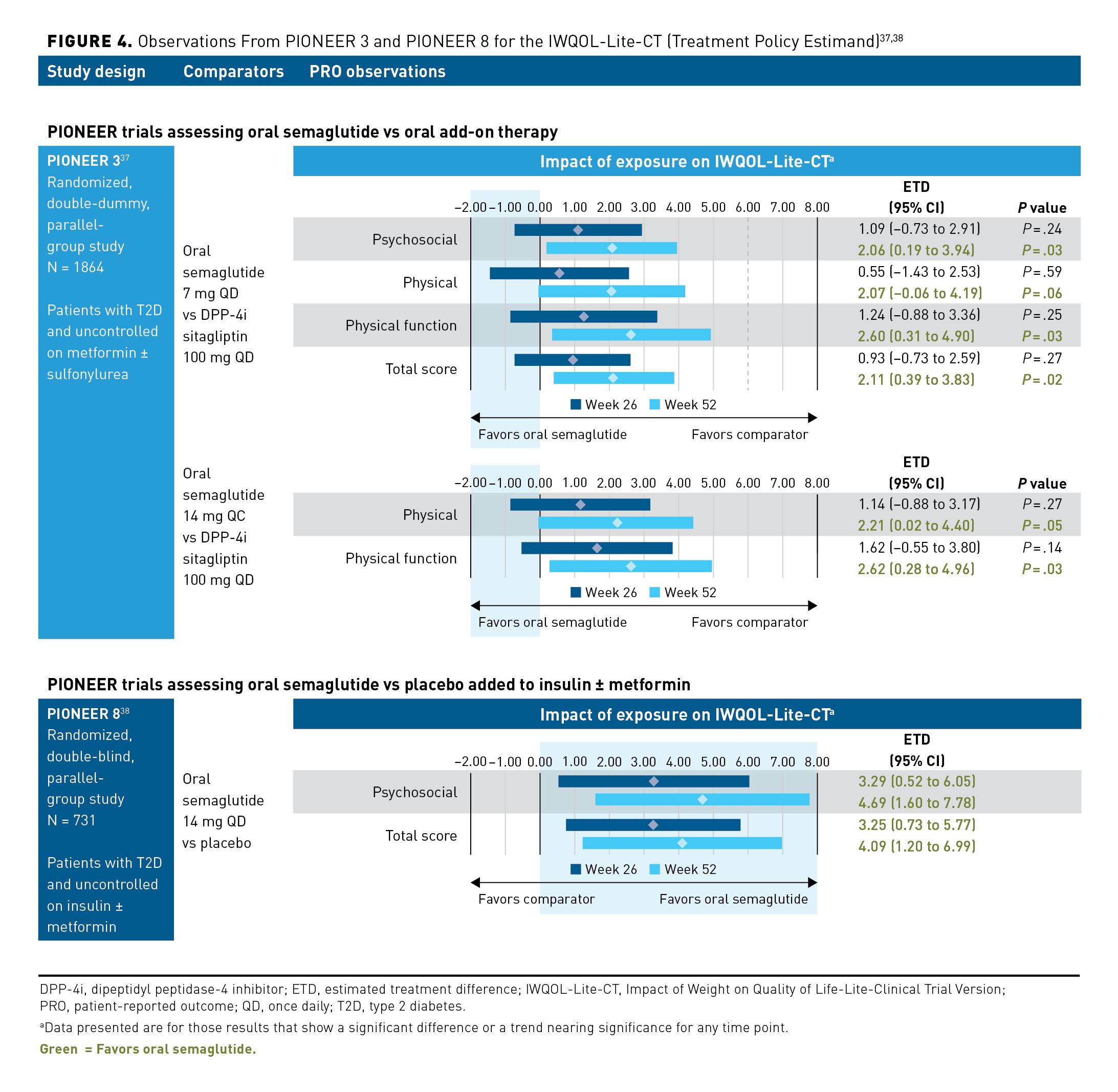
In patients with more advanced disease (PIONEER 8), the ETD significantly favored oral semaglutide 14 mg over placebo for the psychosocial domain and IWQOL-Lite-CT total score at weeks 26 and 52.38 Reductions in body weight resulting from the addition of oral semaglutide may be reflected by improved patient mood.38
Discontinuations in the PIONEER Clinical Trial Program
When evaluating PRO observations from the PIONEER program, it is important to consider the proportion of patients who discontinued treatment. In PIONEER 4, 5, and 8, a higher proportion of patients discontinued treatment due to adverse events (AEs) with oral semaglutide compared with placebo.38,39,41 Similar proportions discontinued oral semaglutide and liraglutide due to AEs in PIONEER 4, and more patients discontinued oral semaglutide than empagliflozin in PIONEER 2.36,41 Although similar proportions discontinued oral semaglutide 3 mg and 7 mg and sitagliptin due to AEs in PIONEER 3, higher proportions discontinued oral semaglutide 14 mg.37 In PIONEER 7, more patients discontinued oral semaglutide flexible dosing compared with sitagliptin.40 Gastrointestinal AEs were the primary reason for discontinuing oral semaglutide in all studies, despite the effects being mild to moderate and transient in nature.36-41 Treatment discontinuations are discussed in other articles from this supplement32,42,45; however, using a patient-centered approach and incorporating shared decision-making between the clinician and patient could further minimize the rates of discontinuation.45 The AE profile for oral semaglutide was consistent with that of other GLP-1RAs.46
Implications of PRO Observations for Clinical Practice
T2D is associated with significant impairment in a broad range of HRQOL measures. The concept of HRQOL considers patient perspectives of both physical and mental health.24 It is important that patients receive the right treatment at the right time, based on both clinical and psychosocial conditions.23 A patient-centered collaborative approach is recommended in T2D to optimize both clinical outcomes and HRQOL,19,20 with fully engaged patients more likely to achieve their treatment goals.47
Within the managed care sector, there has been a shift towards value-based care and away from fee-for-service.48 The 3 main components assessed in quality-of-care systems are: 1) clinical effectiveness and goals (A1C level); 2) the patient experience (ie, how patients perceive their care); and 3) results from health outcomes surveys on how patients perceive their physical, mental, and emotional well-being.20,49-51 In light of this, including PROs as end points in clinical trials would directly address this relatively new, but increasingly common, method of evaluating health care services.22
The number of treatment options available, each with its own benefits, risks, and burdens, makes T2D a highly patient preference–sensitive disease.20 Hence, insight from PRO data can help those involved in patient care gain a better understanding of the patient experience and health outcomes, resulting in more appropriate treatment decisions.20 GLP-1RAs, which have consistently demonstrated good efficacy and tolerability in patients with T2D and also offer patients additional benefits such as weight loss and a low risk of hypoglycemia,21 could positively impact patient experience and health outcomes. However, until the recent approval of oral semaglutide, GLP-1RAs were only available in injectable form; consequently, attributes including dosing frequency, injection device, and injection convenience impacted patient preferences, and, in turn, adherence.24,52
Established PRO instruments have been used to assess the effects of GLP-1RAs administered once- or twice-daily (eg, liraglutide, lixisenatide, and exenatide) or once-weekly (exenatide extended-release, dulaglutide, and semaglutide).24 The requirement for fewer injections was associated with increased patient preference for once-weekly GLP-1RAs.24 When compared with oral glucose-lowering medications, once-weekly GLP-1RAs demonstrated some advantages with regard to glycemic control, weight, and hypoglycemia risk that, in some cases, were associated with significant improvements in corresponding measures of HRQOL.24
Treatment satisfaction and HRQOL with once-weekly GLP-1RAs were compared in 2 studies, SUSTAIN 3 and SUSTAIN 7.53,54 In these studies, semaglutide was associated with significantly greater reductions in A1C levels and weight than exenatide extended-release and dulaglutide and was associated with greater treatment satisfaction compared with exenatide, but not with dulaglutide. No differences were seen between GLP‑1RAs for HRQOL outcomes as measured by the SF-36v2.53,54
Observations from the PIONEER clinical trial program provide further insight as the GLP-1RA class evolves to include a once-daily oral agent. Results were generally similar between oral semaglutide and comparators for all PROs, although there were some exceptions.36-41 The ETDs significantly favored oral semaglutide over almost all comparators (except liraglutide) for the feelings of unacceptably high blood sugars in PIONEER 4, 5, 7, and 8 (based on DTSQs scores), and over empagliflozin for craving control and craving for savory in PIONEER 2 (CoEQ results).36,38-41 Interestingly, glucagon-like peptide-1 receptors in the human brain impact appetite regulation and food reward, and treatment with GLP-1RAs has previously been shown to enhance satiety, reduce hunger, and lower food intake.55,56 In patients with renal impairment and those with more advanced disease (PIONEER 5 and PIONEER 8, respectively), some HRQOL domains and component summaries significantly favored oral semaglutide over placebo.38,39 In PIONEER 2, oral semaglutide 14 mg was significantly favored over empagliflozin 25 mg in general health and social functioning at week 26 for the SF-36v2, whereas empagliflozin 25 mg was significantly favored over semaglutide 14 mg for the physical HRQOL domains, role-physical, and the physical component summary at week 52.36 In the PIONEER 3 and PIONEER 7 studies,37,40 the majority of HRQOL results were similar between oral semaglutide and sitagliptin, which is important to highlight considering that sitagliptin is generally observed in clinical practice as a well-tolerated treatment option.57 In some cases, these observations were seen in parallel to improvements in clinical outcomes (A1C and body weight reductions).37-41
It is important to acknowledge the limitations and challenges of using PRO instruments in clinical trials and for guiding clinical practice. Although there is a standardized approach to PRO assessments in other indications (eg, cancer), there remains a lack of consensus regarding the most important PRO domains in diabetes.8 Because of the length of PRO questionnaires used in clinical trials, it can be difficult to implement them in clinical practice.58 Shorter validated questionnaires could be utilized more easily in clinical practice and provide added value for patients, resulting in more personalized and appropriate treatment, and ultimately better performance from a managed care perspective.
Diabetes care is complex and involves interdisciplinary teams, including diabetes nurse specialists, pharmacists, behavioral and social workers, nutritionists, care navigators, and case managers, in addition to physicians.59 Therefore, it is increasingly important for interdisciplinary team members to better understand their patients, and not just their A1C levels. PRO instruments can facilitate this, providing the team with information that allows them to communicate with their patients in a patient-centered way. The PRO observations across the PIONEER clinical trial program add to the growing evidence base for GLP-1RAs and T2D therapies in general, helping those involved in managed care at all levels make better informed decisions about therapeutic options for patients beyond the effects on glycemic control.
Acknowledgments
This article was supported by Novo Nordisk Inc; the company was provided with the opportunity to perform a medical accuracy review. Under the direction of the authors, medical writing and editorial support was provided by Nicole Cash of Axis, a division of Spirit Medical Communications Group Limited (funded by Novo Nordisk Inc).
Author affiliations: Tandigm Health (DS); WellDyne (PTA); Jefferson Health (TD).
Funding source: Financial support for this work was provided by Novo Nordisk Inc.
Author disclosures: Dr Schneider reports being a speaker for Novo Nordisk Inc, and a consultant for Eli Lilly and HealthCast. Dr Taddei-Allen reports that she is an advisory board member for Novo Nordisk Inc. Dr Dougherty has no relevant financial relationships with commercial interests to disclose.
Authorship information: Drafting the manuscript (DS, PTA, TD); critical revision of the manuscript for important intellectual content (DS, PTA, TD); responsibility for content (DS, PTA, TD).
Address correspondence to: Doron Schneider, MD, 300 Four Falls Corporate Center, 300 Conshohocken State Rd, Suite 260, Conshohocken, PA 19428. Email: dsch2699@gmail.com. Phone: +1 215 858 1067.
References
1. Canon A, Handelsman Y, Heile M, Shannon M. Burden of illness in type 2 diabetes mellitus. J Manag Care Spec Pharm. 2018;24(9-a Suppl):S5-S13. doi:10.18553/jmcp.2018.24.9-a.s5
2. Levterova BA, Orbetzova M, Levterov G, Dimitrova D, Todorov P. Assessment of the impact of type 2 diabetes on the Quality of Life by Audit of Diabetes-Dependent Quality-of-Life (ADDQoL-19). Biotechnology & Biotechnological Equipment. 2018:32(6);1627-1634. doi:10.1080/13102818.2018.1532319
3. Bradley C, Eschwège E, Pablos-Velasco P, et al. Predictors of quality of life and other patient-reported outcomes in the PANORAMA multinational study of people with type 2 diabetes. Diabetes Care. 2018;41(2):267-276. doi:10.2337/dc16-2655
4. American Diabetes Association. 6. Glycemic targets: Standards of Medical Care in Diabetes-2020. Diabetes Care. 2020;43(suppl 1):S66-S76. doi:10.2337/dc20-S006
5. Garber AJ, Handelsman Y, Grunberger G, et al. Consensus statement by the American Association of Clinical Endocrinologists and American College of Endocrinology on the comprehensive type 2 diabetes management algorithm - 2020 Executive Summary. Endocr Pract. 2020;26(1):107-139. doi:10.4158/CS-2019-0472
6. Saisho Y. Use of diabetes treatment satisfaction questionnaire in diabetes care: importance of patient-reported outcomes. Int J Environ Res Public Health. 2018;15(5):947. doi:10.3390/ijerph15050947
7. Barbosa CD, Balp MM, Kulich K, Germain N, Rofail D. A literature review to explore the link between treatment satisfaction and adherence, compliance, and persistence. Patient Prefer Adherence. 2012;6:39-48. doi:10.2147/PPA.S24752
8. Marrero DG, Hilliard ME, Maahs DM, McAuliffe-Fogarty AH, Hunter CM. Using patient-reported outcomes in diabetes research and practice: recommendations from a national workshop. Diabetes Res Clin Pract. 2019;153:23-29. doi:10.1016/j.diabres.2019.05.016
9. Hayes RP, Schultz EM, Naegeli AN, Curtis BH. Test-retest, responsiveness, and minimal important change of the ability to perform physical activities of daily living questionnaire in individuals with type 2 diabetes and obesity. Diabetes Technol Ther. 2012;14(12):1118-1125. doi:10.1089/dia.2012.0123
10. Meadows KA, Abrams C, Sandbaek A. Adaptation of the Diabetes Health Profile (DHP-1) for use with patients with type 2 diabetes mellitus: psychometric evaluation and cross-cultural comparison. Diabet Med. 2000;17(8):572-580. doi:10.1046/j.1464-5491.2000.00322.x
11. Janssen MF, Pickard AS, Golicki D, et al. Measurement properties of the EQ-5D-5L compared to the EQ-5D-3L across eight patient groups: a multi-country study. Qual Life Res. 2013;22(7):1717-1727. doi:10.1007/s11136-012-0322-4
12. Kolotkin RL, Williams VSL, Ervin CM, et al. Validation of a new measure of quality of life in obesity trials: Impact of Weight on Quality of Life-Lite Clinical Trials Version. Clin Obes. 2019;9:e12310. doi:10.1111/cob.12310
13. Manwaring J, Wilfley D. The Impact of Weight on Quality of Life Questionnaire. In: Preedy VR, Watson RR, eds. Handbook of Disease Burdens and Quality of Life Measures. Springer; 2010:210-225.
14. Hayes RP, DeLozier AM. Reliability, validity, and responsiveness of the Impact of Weight on Self-Perceptions Questionnaire (IW-SP) in individuals with type 2 diabetes and obesity. Diabetes Technol Ther. 2015;17(3):210-214. doi:10.1089/dia.2014.0142
15. Matza LS, Boye KS, Yurgin N. Validation of two generic patient-reported outcome measures in patients with type 2 diabetes. Health Qual Life Outcomes. 2007:5;47. doi:10.1186/1477-7525-5-47
16. 36-item Short-Form Survey (SF-36) scoring instructions. RAND Corporation. Accessed May 17, 2020. https://www.rand.org/health-care/surveys_tools/mos/36-item-short-form/scoring.html
17. Dalton M, Finlayson G, Hill A, Blundell J. Preliminary validation and principal components analysis of the Control of Eating Questionnaire (CoEQ) for the experience of food craving. Eur J Clin Nutr. 2015;69(12):1313-1317. doi:10.1038/ejcn.2015.57
18. Van der Wees PJ, Verkerk EW, Verbiest MEA, et al. Development of a framework with tools to support the selection and implementation of patient-reported outcome measures. J Patient Rep Outcomes. 2019;3(1);75. doi:10.1186/s41687-019-0171-9
19. American Diabetes Association. 4. Comprehensive Medical Evaluation and Assessment of Comorbidities: Standards of Medical Care in Diabetes-2019. Diabetes Care. 2019;42(suppl 1):S34-S45. doi:10.2337/dc19-S004
20. Davies MJ, D’Alessio DA, Fradkin J, et al. Management of hyperglycemia in type 2 diabetes, 2018. A consensus report by the American Diabetes Association (ADA) and the European Association for the Study of Diabetes (EASD). Diabetes Care. 2018;41:2669-2701. doi:10.2337/dci18-0033
21. Thieu VT, Robinson S, Kennedy-Martin T, Boye KS, Garcia-Perez L-E. Patient preferences for glucagon-like peptide 1receptor–agonist treatment attributes. Patient Prefer Adherence. 2019;13:561-576. doi:10.2147/PPA.S187907
22. Gibbons E, Black N, Fallowfield L, Newhouse R, Fitzpatrick R. Patient-reported outcome measures and the evaluation of services. In: Raine R, Fitzpatrick R, Barratt H, et al, eds. Challenges, solutions and future directions in the evaluation of service innovations in health care and public health. Health Serv Delivery Research; 2016;55-68.
23. Suzuki S, Oura T, Taeuchi M, Boye KS. Evaluation of the impact of once weekly dulaglutide on patient-reported outcomes in Japanese patients with type 2 diabetes: comparisons with liraglutide, insulin glargine, and placebo in two randomized studies. Health Qual Life Outcomes. 2017;15(1):123. doi:10.1186/s12955-017-0696-7
24. Billings LK, Handelsman Y, Heile M, Schneider D, Wyne K. Health-related quality of life assessments with once-weekly glucagon-like peptide-1 receptor agonists in type 2 diabetes mellitus. J Manag Care Spec Pharm. 2018;24(suppl 9-a):S30-S41. doi:10.18553/jmcp.2018.24.9-a.s30
25. Brown RE, Abitbol A, Bajaj HS, et al. Patient reported outcomes following initiation of glucagon-like peptide-1 receptor agonists in patients with type 2 diabetes in a specialist endocrinology practice of the LMC diabetes registry: the PROGRESS-Diabetes study. Diabetes Res Clin Pract. 2019;156:107820. doi:10.1016/j.diabres.2019.107820
26. Van Gaal L, Scheen A. Weight management in type 2 diabetes: current and emerging approaches to treatment. Diabetes Care. 2015;38(6):1161-1172. doi:10.2337/dc14-1630
27. American Diabetes Association. 9. Pharmacologic approaches to glycemic treatment: Standards of Medical Care in Diabetes-2020. Diabetes Care. 2020;43(suppl 1):S98-S110. doi:10.2337/dc20-S009
28. Ul-Haq Z, Mackay DF, Fenwick E, Pell JP. Meta-analysis of the association between body mass index and health related quality of life among adults, assessed by the SF-36. Obesity (Silver Spring). 2013;21(3):E322-E327. doi:10.1002/oby.20107
29. Gough SC, Kragh N, Ploug UJ, Hammer M. Impact of obesity and type 2 diabetes on health-related quality of life in the general population in England. Diabetes Metab Syndr Obes. 2009;2:179-184. doi:10.2147/dmsott.s7088
30. Aroda VR. A review of GLP-1 receptor agonists: evolution and advancement through the lens of randomised controlled trials. Diabetes Obes Metab. 2018;20(suppl 1):22-33. doi:10.1111/dom.13162
31. DiBonaventura M, Wagner JS, Girman CJ, et al. Multinational internet-based survey of patient preference for newer oral or injectable type 2 diabetes medication. Patient Prefer Adherence. 2010:4;397-406. doi:10.2147/PPA.S14477
32. Dougherty T, Heile M. Type 2 diabetes in the US managed care setting: the burden of disease and rationale for an oral glucagon-like peptide-1 receptor agonist. Am J Manag Care. 2020;26(suppl 16):S325-S334. doi:10.37765/ajmc.2020.88552
33. Rybelsus. Prescribing Information. Novo Nordisk Inc; 2020. Accessed April 15, 2020. https://www.accessdata.fda.gov/drugsatfda_docs/label/2020/213182s000,213051s001lbl.pdf
34. Rybelsus. Annex I: summary of product characteristics. Novo Nordisk Inc; 2020. Accessed June 10, 2020. https://www.ema.europa.eu/en/documents/product-information/rybelsus-epar-product-information_en.pdf
35. Rybelsus approved in Japan for the treatment of type 2 diabetes. Company announcement. Novo Nordisk Inc. June 29, 2020. Accessed September 3, 2020. https://ml-eu.globenewswire.com/Resource/Download/46a404a8-4e2b-41d5-a5fa-fa36cfae964f
36. Rodbard HW, Rosenstock J, Canani LH, et al; PIONEER 2 Investigators. Oral semaglutide versus empagliflozin in patients with type 2 diabetes uncontrolled on metformin: the PIONEER 2 trial. Diabetes Care. 2019;42(12):2272-2281. doi:10.2337/dc19-0883
37. Rosenstock J, Allison D, Birkenfeld AL, et al; PIONEER 3 Investigators. Effect of additional oral semaglutide vs sitagliptin on glycated hemoglobin in adults with type 2 diabetes uncontrolled with metformin alone or with sulfonylurea: the PIONEER 3 randomized clinical trial. JAMA. 2019;321(15):1466-1480. doi:10.1001/jama.2019.2942
38. Zinman B, Aroda VR, Buse JB, et al; PIONEER 8 Investigators. Efficacy, safety, and tolerability of oral semaglutide versus placebo added to insulin with or without metformin in patients with type 2 diabetes: the PIONEER 8 trial. Diabetes Care. 2019;42(12):2262-2271. doi:10.2337/dc19-0898
39. Mosenzon O, Blicher TM, Rosenlund S, et al; PIONEER 5 Investigators. Efficacy and safety of oral semaglutide in patients with type 2 diabetes and moderate renal impairment (PIONEER 5): a placebo-controlled, randomised, phase 3a trial. Lancet Diabetes Endocrinol. 2019;7(7):515-527. doi:10.1016/S2213-8587(19)30192-5
40. Pieber TR, Bode B, Mertens A, et al; PIONEER 7 investigators. Efficacy and safety of oral semaglutide with flexible dose adjustment versus sitagliptin in type 2 diabetes (PIONEER 7): a multicentre, open-label, randomised, phase 3a trial. Lancet Diabetes Endocrinol. 2019;7(7):528-539. doi:10.1016/S2213-8587(19)30194-9
41. Pratley R, Amod A, Hoff ST, et al; PIONEER 4 investigators. Oral semaglutide versus subcutaneous liraglutide and placebo in type 2 diabetes (PIONEER 4): a randomised, double-blind, phase 3a trial. Lancet. 2019;394(10192):39-50. doi:10.1016/S0140-6736(19)31271-1
42. Rodbard HW, Dougherty T, Taddei-Allen P. Efficacy of oral semaglutide: overview of the PIONEER clinical trial program and implications for managed care. Am J Manag Care. 2020;26(suppl 16):S335-S343. doi:10.37765/ajmc.2020.88554
43. Aroda VR, Saugstrup T, Buse JB, Donsmark M, Zacho J, Davies MJ. Incorporating and interpreting regulatory guidance on estimands in diabetes clinical trials: the PIONEER 1 randomized clinical trial as an example. Diabetes Obes Metab. 2019;21(10):2203-2210. doi:10.1111/dom.13804
44. Hawthorne G, Osborne RH, Taylor A, Sansoni J. The SF36 version 2: critical analyses of population weights, scoring algorithms and population norms. Qual Life Res. 2007;16(4):661-673. doi:10.1007/s11136-006-9154-4
45. Lingvay I, Taddei-Allen P, Dougherty T. Cardiovascular outcomes, safety, and tolerability with oral semaglutide: insights for managed care. Am J Manag Care. 2020;26(suppl 16):S344-S355. doi:10.37765/ajmc.2020.88555
46. Nauck MA, Meier JJ. Are all GLP-1 agonists equal in the treatment of type 2 diabetes? Eur J Endocrinol. 2019;181(6):R211-R234. doi:10.1530/EJE-19-0566
47. Inzucchi SE, Bergenstal RM, Buse HJ, et al. Management of hyperglycemia in type 2 diabetes, 2015: a patient centered approach: update to a position statement of the American Diabetes Association and the European Association for the Study of Diabetes. Diabetes Care. 2015;38(1):140-149. doi:10.2337/dc14-2441
48. Nash DB, Skoufalos A, Harris D. Achieving a patient-centered, value-based system of diabetes care in the United States: report on a national stakeholder summit. Popul Health Manag. 2018;21(1):20-23. doi:10.1089/pop.2017.0131
49. HEDIS. HEDIS measures and technical resources. Accessed October 13, 2020. https://www.ncqa.org/hedis/measures/
50. HOS. Medicare health outcomes survey. Accessed October 13, 2020. https://www.cms.gov/Research-Statistics-Data-and-Systems/Research/HOS
51. CAHPS. CAHPS patient experience surveys and guidance. Accessed October 13, 2020. https://www.ahrq.gov/cahps/surveys-guidance/index.html
52. Matza LS, Boye KS, Stewart KD, Davies EW, Paczkowksi R. Health state utilities associated with attributes of weekly injection devices for the treatment of type 2 diabetes. BMC Health Serv Res. 2017:17(1);774. doi:10.1186/s12913-017-2648-7
53. Ahmann A, Capehorn M, Charpentier G, et al. Efficacy and safety of once-weekly semaglutide versus exenatide ER in subjects with type 2 diabetes (SUSTAIN 3): a 56-week, open-label, randomized clinical trial. Diabetes Care. 2018:41(2);258-266. doi:10.2337/dc17-0417
54. Pratley RE, Aroda VR, Lingvay I, et al; SUSTAIN 7 investigators. Semaglutide versus dulaglutide once weekly in patients with type 2 diabetes (SUSTAIN 7): a randomised, open-label, phase 3b trial. Lancet Diabetes Endocrinol. 2018;6(4):275-286. doi:10.1016/S2213-8587(18)30024-X
55. Blundell J, Finlayson G, Axelsen M, et al. Effects of once-weekly semaglutide on appetite, energy intake, control of eating, food preference and body weight in subjects with obesity. Diabetes Obes Metab. 2017;19(9):1242-1251. doi:10.1111/dom.12932
56. Gabery S, Salinas CG, Paulsen SJ, et al. Semaglutide lowers body weight in rodents via distributed neural pathways. JCI Insight. 2020;5(6):e133429. doi:10.1172/jci.insight.133429
57. Scott LJ. Sitagliptin: a review in type 2 diabetes. Drugs. 2017;77(2):209-224. doi:10.1007/s40265-016-0686-9
58. Rolstad S, Adler J, Rydén A. Response burden and questionnaire length: is shorter better? A review and meta-analysis. Value Health. 2011;14(8):1011-1108. doi:10.1016/j.jval.2011.06.003
59. Berkowitz SA, Eisenstat AS, Barnard LS. Multidisciplinary coordinated care for type 2 diabetes:
a qualitative analysis of patient perspectives. Prim Care Diabetes. 2018;12(3):218-223.
doi:10.1016/j.pcd.2018.01.005

